2020 MERCEDES-BENZ CLS tow
[x] Cancel search: towPage 375 of 546
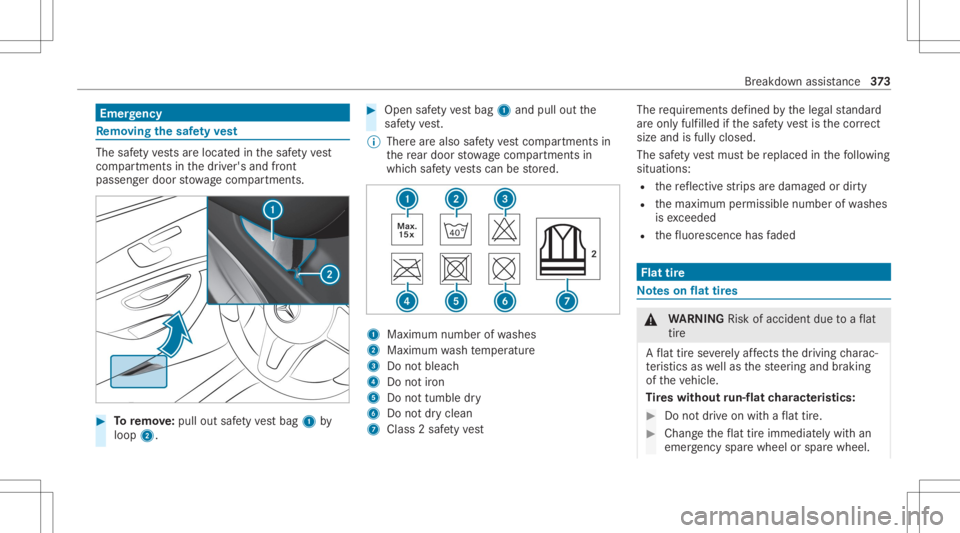
Emer
gency Re
mo ving the safetyve st The
safetyve stsar elocat edinthesaf etyve st
com partments inthedr iver's andfront
passeng erdoor stow agecom partment s. #
Toremo ve:pu llou tsa fety vest bag 1by
loop 2. #
Open safetyve st bag 1and pulloutthe
saf etyve st.
% Ther ear ealso safetyve st com partments in
th ere ar door stow agecom partment sin
whic hsaf etyve stscan bestor ed. 1
Maximum numberofwa shes
2 Maximum wash temp eratur e
3 Donotbleac h
4 Donotiron
5 Donottumble dry
6 Donotdr yclean
7 Class 2saf etyve st The
requ iremen tsdef ined bytheleg alstandar d
ar eon lyfulfille d ifth esaf etyve st isthecor rect
size andisful lyclos ed.
The safetyve st mus tbe replaced inthefo llo wing
situat ions:
R there flect ive st rips aredamag edordir ty
R themaximum permissible numberofwa shes
is exc eeded
R thefluor esc ence has faded Flat
tire No
teson flat tires &
WARNIN GRisk ofacci dent dueto aflat
tir e
A flat tirese verely affects thedr iving charac‐
te rist ics aswellas thesteer ing and braking
of theve hicle.
Ti re swith outrun-flat charact eristics : #
Donotdr ive on withaflat tire. #
Chan getheflat tireimm ediat elywit han
emer gency sparewheel orspar ewheel. Br
eakdo wnassis tance 37
3
Page 380 of 546
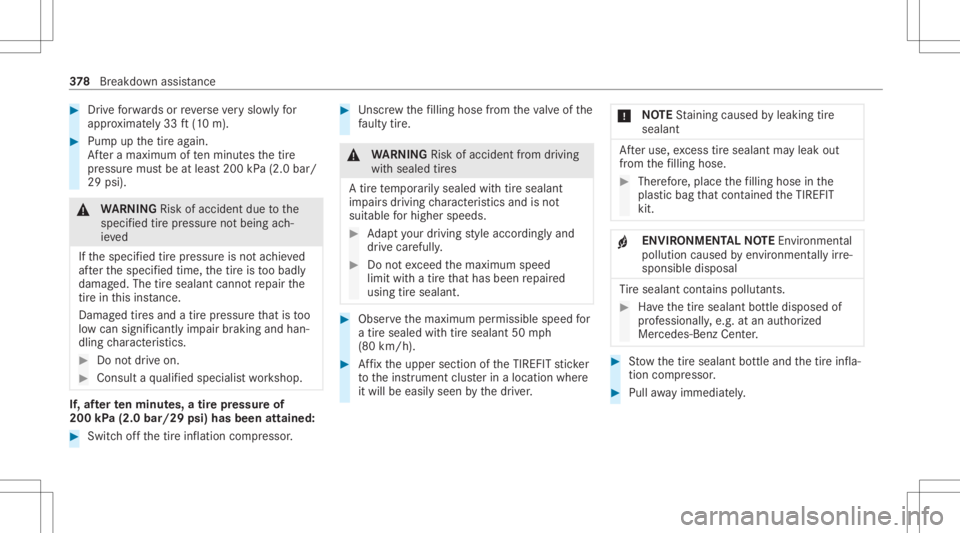
#
Drive fo rw ards orreve rseve ry slo wlyfo r
appr oximat ely33 ft(10 m). #
Pum pup thetir eag ain.
Af tera maximu mof tenminu testh etir e
pr essur emus tbe atleas t200 kPa(2.0 bar/
29 psi). &
WARNIN GRisk ofacci dent dueto the
specif iedtirepr essur eno tbeing ach‐
ie ve d
If th especif iedtirepr essur eis no tac hie ved
af te rth especif iedtime, thetir eis toobadl y
damag ed.The tiresealant cannotrepair the
tir ein this ins tance.
Dama gedtir es and atir epr essur eth at istoo
lo w can significan tly im pair brakin gand han‐
dling charact eristic s. #
Donotdr ive on . #
Con sult aqu alif ied spec ialistwo rkshop. If,
afte rte nminut es,atir epr essur eof
200 kPa(2.0 bar/29 psi)hasbeen attained: #
Switc hof fth etir einf lation compressor . #
Unscr ew thefilling hose from theva lve of the
fa ulty tire. &
WARNIN GRisk ofacci dent from drivi ng
wi th sealed tires
A tir ete mp orarily sealed withtir esealant
im pair sdr iving charact eristic sand isno t
suit able forhighe rspee ds. #
Adaptyo ur drivin gst yle accor dinglyand
dr ive car efull y. #
Donotexc eed themaximum speed
limit withatir eth at has been repair ed
using tiresealant. #
Obser vethemaximum permissible speedfor
a tir esealed withtir esealan t50 mph
(80 km/ h). #
Affix th eupper sectionoftheTIREFI Tst icke r
to theins trument clusterin alocati onwher e
it wil lbe easi lyseen bythedr iver . *
NO
TEStainin gcaus edbyleakin gtir e
sealant Af
teruse, excess tiresealant mayleak out
fr om thefilling hose. #
Ther efor e, place thefilling hose inthe
plas ticbag that con tained theTIREFI T
kit. +
ENVIR
ONMEN TALNO TEEnvironme ntal
po lluti on cau sed byenvironmen tally irre ‐
sponsible disposal Ti
re seala ntcont ains pollu tants. #
Have thetir esealant bottle disposed of
pr ofessionall y,e.g. atan aut hor ized
Mer cedes- BenzCenter. #
Stow thetir esealant bottle and thetir einf la‐
tion compressor . #
Pull away immed iately. 37
8
Brea kdo wnassista nce
Page 387 of 546
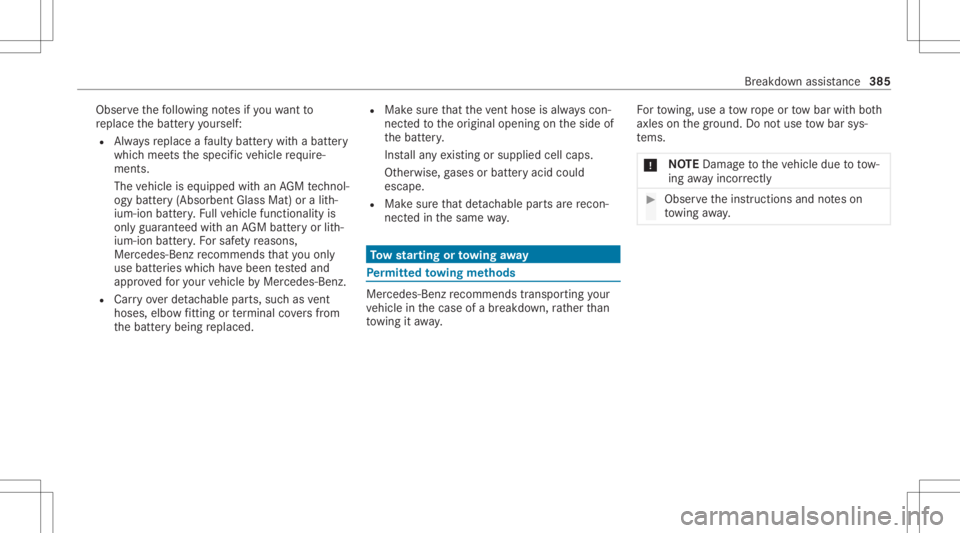
Obser
vethefo llo wing notesif yo uwa ntto
re place thebatt eryyo urself :
R Alw aysre place afa ulty battery wit habatt ery
whic hmee tsthespecif icvehicle requ ire‐
men ts.
The vehicle iseq uipped withan AGMtech nol ‐
ogy batter y(A bso rbentGlas sMa t)or alith ‐
ium-io nbatt ery. Fu llve hicle functionality is
onl yguar anteed withan AGMbatt eryor lith‐
ium-ion battery. Fo rsaf etyre ason s,
Mer cedes-Ben zre comme ndsthat youon ly
use batteries whic hha ve been tested and
appr ovedfo ryo ur vehicle byMer cedes-Ben z.
R Carryove rde tach able parts,suc has vent
hos es,elbo wfitting orterm inal covers from
th ebatt erybeing replaced. R
Mak esur eth at theve nt hos eis alwa ys con‐
nect edtotheor iginal opening ontheside of
th ebatt ery.
Ins tallan yex istin gor supplied cellcaps.
Ot her wise, gases orbatt eryacid could
escape.
R Mak esur eth at detach able partsarere con‐
nect edinthesame way. To
w star ting ortowing away Pe
rm itted towing methods Mer
cede s-Ben zre comme ndstransp orting your
ve hicle inthecase ofabr eakdo wn,rath er than
to wing itaw ay. Fo
rto wing, useato w rope ortow bar withbo th
axle son thegr ound. Donotuse tow bar sys‐
te ms.
* NO
TEDama getotheve hicle duetotow‐
ing away inc orrectl y #
Obs erve theins truction sand noteson
to wing away. Br
ea kdo wnassista nce 38
5
Page 388 of 546
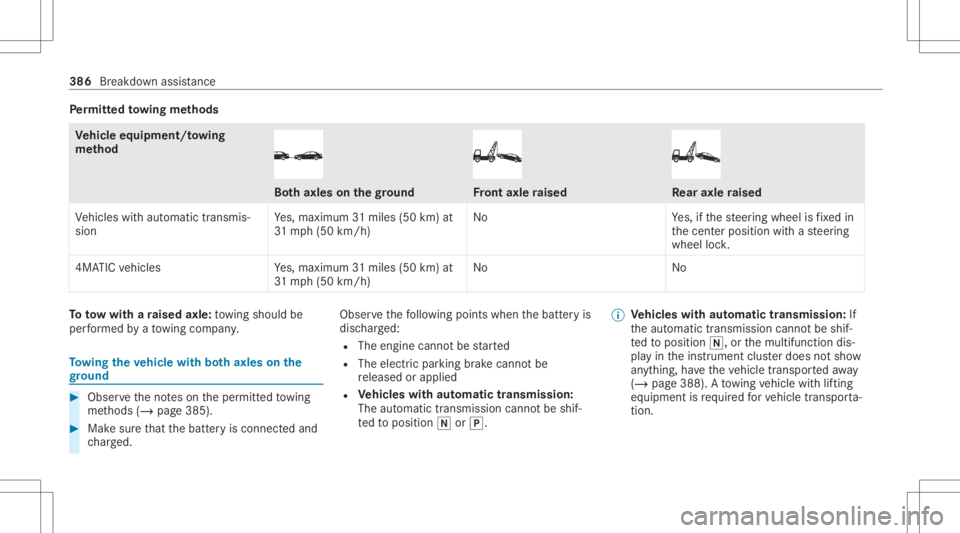
Pe
rm itted towing methods Ve
hicl eeq uipment/ towing
me thod Bo
th axle son thegr ound Fr
ont axle raised Re
ar axle raised
Ve hicles withaut omatic transmis‐
sion Ye
s,maximum 31mile s(50 km) at
31 mp h(50 km/h) No
Yes,ifth esteer ing wheel isfixe din
th ecent erposition withast eer ing
wheel lock.
4MA TICvehicles Yes,maximum 31mile s(50 km) at
31 mp h(50 km/h) No
NoTo
tow wit hara ised axle: towing should be
per form ed byato wing company. To
wing theve hicl ewith both axle son the
gr ound #
Obser vetheno teson theper mitt edtowing
me thods (/page385). #
Mak esur eth at thebatt eryis con nect edand
ch arge d. Obser
vethefo llo wing pointswhen thebatt eryis
disc harged:
R The engin ecann otbe star ted
R The electr icpar king brak ecann otbe
re leased orapplied
R Vehicl eswith automatic transmiss ion:
The automatic transmiss ioncanno tbe shif‐
te dto position 005Cor005D. %
Vehicl eswith automatic transmiss ion:If
th eaut omatic transmiss ioncann otbe shif‐
te dto position 005C,orthemultifunc tiondis‐
pla yin theins trument clusterdoes notsho w
an ything, have theve hicle transpor tedaw ay
( / pag e388). Atowing vehicle withlifting
eq uipment isrequ ired forve hicle transpor ta‐
tio n. 38
6
Brea kdo wnassist anc e
Page 389 of 546
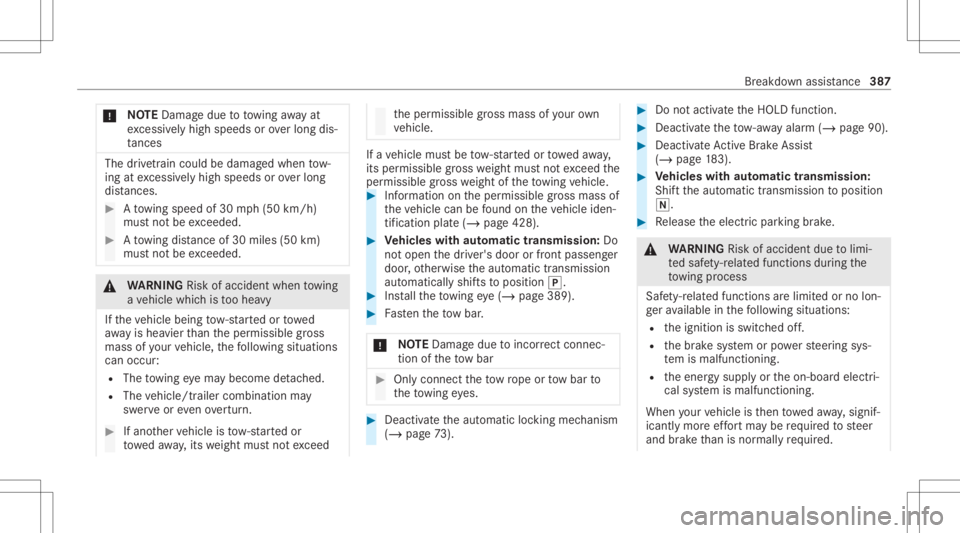
*
NO
TEDama gedue totowing away at
exc essiv elyhigh speeds orove rlong dis‐
ta nces The
drivet ra in could bedamag edwhen tow‐
ing atexc essiv elyhigh speeds orover long
dis tances. #
Atowing speed of30 mph(50 km/h)
mus tno tbe exc eeded. #
Atowing distan ceof30 miles(50 km)
mus tno tbe exc eeded. &
WARNIN GRisk ofacci dent whento wing
a ve hicle whichis toohea vy
If th eve hicle being tow- star tedor towe d
aw ay ishea vier than theper missible gross
mass ofyour vehicle, thefo llo wing situat ions
can occur:
R The towing eyema ybecome detach ed.
R The vehicle/tr ailercombination may
sw erve oreve nov ertur n. #
Ifano ther vehicle istow- star tedor
to we daw ay,its weight mustno texc eed th
eper missible gross mass ofyour ow n
ve hicle. If
ave hicle mustbe tow- star tedor towe daw ay,
its per missib legross weight mustno texc eed the
per missible gross weight oftheto wing vehicle. #
Information ontheper missible gross mass of
th eve hicle canbefound ontheve hicle iden‐
tif ication plate(/ page428). #
Vehicl eswith automatic transmiss ion:Do
no topen thedr iver's door orfront passeng er
door ,ot her wise theaut omatic transmiss ion
aut omaticall yshif tsto position 005D. #
Installth eto wing eye(/ page389). #
Fasten theto w bar .
* NO
TEDama gedue toinc orrect connec‐
tion oftheto w bar #
Onlyconnect theto w rope ortow bar to
th eto wing eyes. #
Deact ivat eth eaut omatic locking mechanism
(/ page73 ). #
Donotactiv ateth eHOLD function. #
Deact ivat eth eto w- aw ay alar m(/ page90) . #
Deact ivat eAc tiveBr ak eAssi st
( / pag e18 3). #
Vehicl eswith automatic transmiss ion:
Shif tth eaut omatic transmiss iontoposition
005C. #
Release theelectr icpar king brak e. &
WARNIN GRisk ofacci dent dueto limi‐
te dsaf ety-re lat ed func tionsdur ing the
to wing proce ss
Saf ety-re lat ed func tionsar elimit edorno lon‐
ge rav ailable inthefo llo wing situat ions:
R theignition isswitc hedoff.
R thebr ak esy stem orpowe rst eer ing sys‐
te m ismalfu nctioning.
R theener gysupply ortheon- boar delectr i‐
cal system ismalfunct ioning.
When your vehicle isthen towe daw ay,signif ‐
icant lymor eef fort ma ybe requ ired tosteer
and brak eth an isno rm allyre qu ired. Br
eakdo wnassis tance 38
7
Page 390 of 546
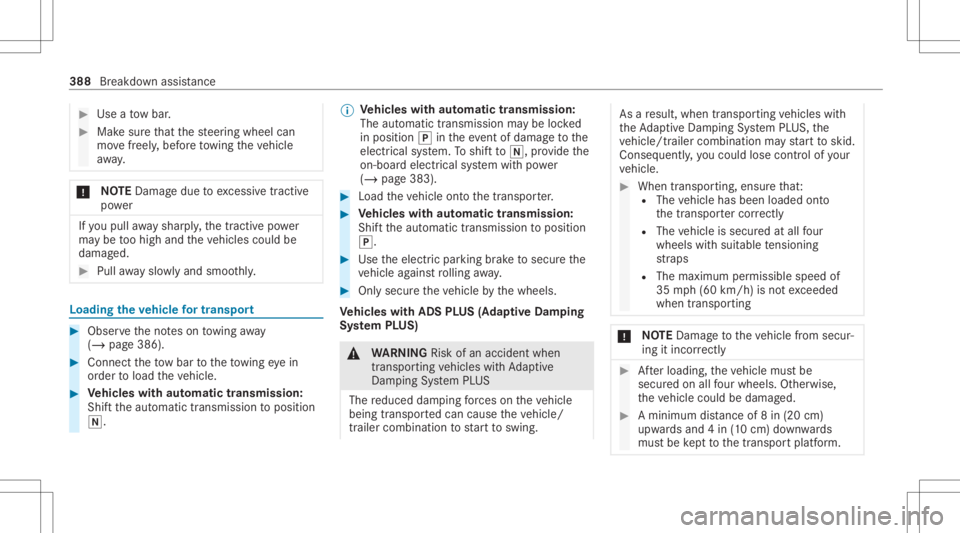
#
Use ato w bar . #
Mak esur eth at thesteer ing wheel can
mo vefreely ,bef oreto wing theve hicle
aw ay. *
NO
TEDama gedue toexcess ive tracti ve
po we r If
yo upull away shar ply, thetractiv epo we r
ma ybe toohigh andtheve hicles couldbe
damag ed. #
Pull away slo wlyand smoo thly. Lo
adi ng the vehicl efo rtr ans port #
Obser vetheno teson towing away
( / pag e386). #
Connec tth eto w bar totheto wing eyein
or der toload theve hicle. #
Vehicl eswith automatic transmiss ion:
Shif tth eaut omatic transmiss iontoposition
005C. %
Ve
hicl eswith automatic transmiss ion:
The automatic transmiss ionmaybe locked
in posit ion005Dintheeve ntofdama getothe
electr icalsystem. Toshif tto 005C ,pr ov ide the
on-boar delectr icalsystem withpo we r
( / pag e383). #
Load theve hicle ontoth etra nspor ter. #
Vehicl eswith automatic transmiss ion:
Shif tth eaut omatic transmiss iontoposition
005D. #
Use theelectr icpar king brak eto secur eth e
ve hicle agains tro lling away. #
Onlysecur eth eve hicle bythewheels.
Ve hicl eswith ADSPL US (Adap tiveDam ping
Sy stem PLUS) &
WARNIN GRisk ofan acci dent when
tr ansp orting vehicles withAd aptive
Dam pingSy stem PLUS
The reduced damping forc es on theve hicle
being transpor tedcan cause theve hicle/
tr ailer combination tostar tto swing. As
are sult, when transpor tingvehicles with
th eAd aptiveDam pingSy stem PLUS, the
ve hicle/tr ailercombination mayst ar tto skid.
Conseq uently,yo uco uld lose contro lof your
ve hicle. #
When transpor ting,ensur eth at:
R The vehicle hasbeen loaded onto
th etranspor tercor rectl y
R The vehicle issecur edatall four
wheel swit hsuit able tensi oni ng
st ra ps
R The maximum permissible speedof
35 mph(6 0km/h) isno texc eeded
when transpor ting *
NO
TEDama getotheve hicle from secur‐
ing itincor rectl y #
Afterloa ding, theve hicle mustbe
secur edon allfour wheel s.Ot her wise,
th eve hicle could bedamag ed. #
Aminimum distance of8in (20 cm)
up wa rdsand 4in (10 cm) down wards
mus tbe kept tothetranspor tplatf orm. 388
Breakdo wnassis tance
Page 392 of 546
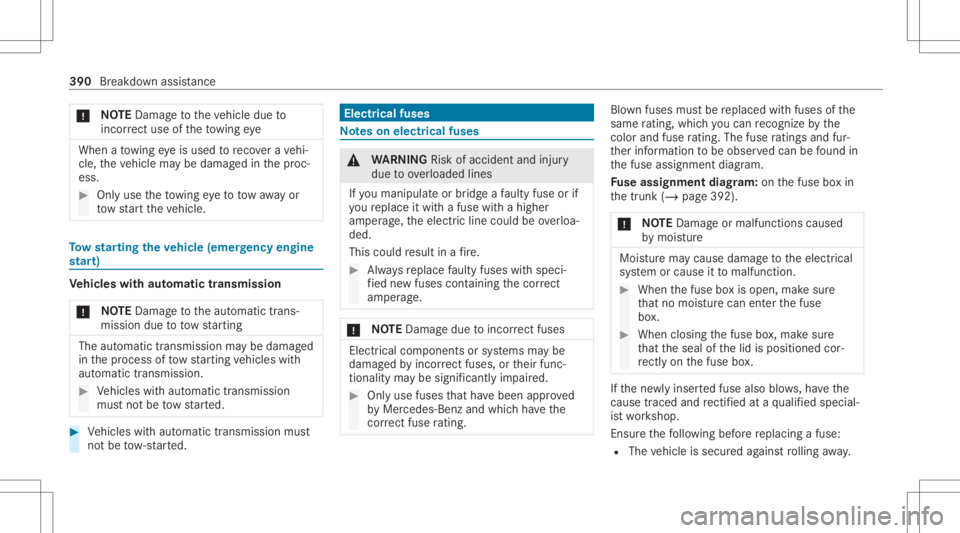
*
NO
TEDama getotheve hicle dueto
inc orrect useof theto wing eye When
ato wing eyeis used toreco vera ve hi‐
cle, theve hicle maybe damag edinthepr oc‐
ess. #
Onlyuse theto wing eyeto tow aw ay or
to w star tth eve hicle. To
w star ting theve hicl e(eme rgency engine
st ar t) Ve
hicl eswith automatic transmiss ion
* NO
TEDama getotheaut omatic trans‐
mission duetotow star tin g The
automat ictransm issionma ybe damag ed
in thepr ocess oftow star tin gve hicles with
aut omatic transmission. #
Vehicles withaut omatic transmission
mus tno tbe tow star ted. #
Vehicles withaut omatic transmission must
no tbe tow- star ted. Electr
icalfuses No
teson electr icalfuses &
WARNIN GRisk ofacci dent andinjury
due tooverloaded lines
If yo uman ipulat eor bridg eafa ulty fuse orif
yo ure place itwit hafuse withahigher
am per age, theelectr icline could beove rloa‐
ded.
This could result inafire . #
Alw aysre place faulty fuseswit hspec i‐
fi ed newfuses containin gth ecor rect
am per age. *
NO
TEDama gedue toinc orrect fus es Electr
icalcom pone ntsorsystems maybe
damag edbyinc orrect fus es, ortheir func ‐
tion ality maybe signif icantlyim pair ed. #
Onlyuse fuses that have been approved
by Mer cedes-Ben zand whic hha ve the
cor rect fus era ting . Blo
wn fuse smu stbe replaced withfuses ofthe
same rating ,wh ich yo ucan recogni zeby the
colo rand fusera ting .The fuse rating sand fur‐
th er information tobe obser vedcan befound in
th efuse assignmen tdiagr am.
Fu se assignment diagram: onthefuse boxin
th etrunk (/page392).
* NO
TEDama geormalfunct ionscaused
by mois ture Mois
turema ycause damagetotheelectr ical
sy stem orcause itto malfu nction. #
When thefuse boxis open, makesur e
th at no mois turecan enterthefuse
bo x. #
When closing thefuse box,mak esur e
th at theseal ofthelid isposition edcor‐
re ctly onthefuse box. If
th ene wlyinser tedfuse alsoblows,ha ve the
cau setrace dand rectif ied at aqu alif ied spec ial‐
is two rkshop.
Ensur eth efo llo wing beforere placing afuse:
R The vehicle issecur edagains tro lling away. 390
Breakdo wnassis tance
Page 406 of 546
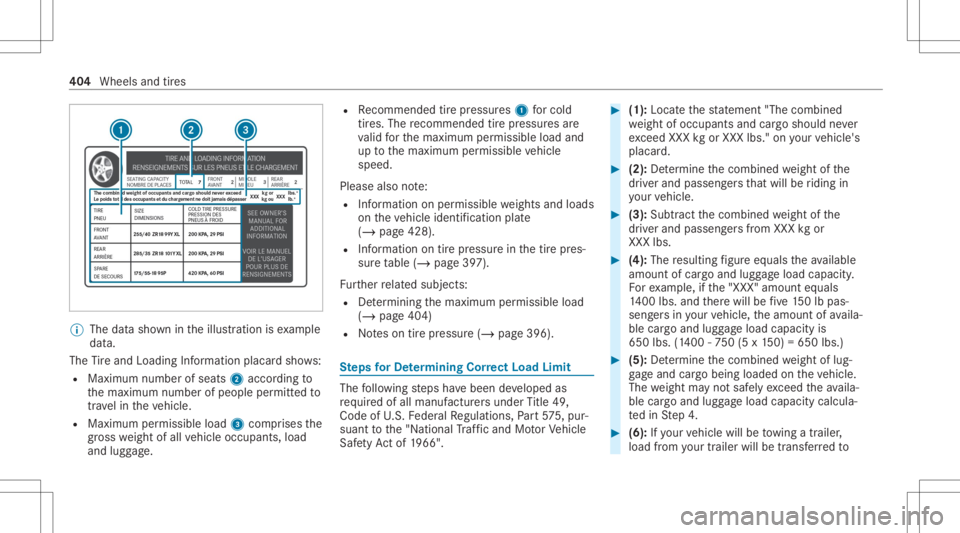
%
The datasho wnintheillus tration isexam ple
dat a.
The Tire and Loadi ngInfo rm atio nplacar dsho ws:
R Maximum numberofseats 2accor dingto
th emaximum numberofpeople permitt edto
tr ave lin theve hicle.
R Maximum permissible load3com prises the
gr os swe ight ofall vehicle occupants, load
and luggage. R
Recomme ndedtirepr ess ures 1 forcold
tir es. The recomme ndedtirepr ess ures are
va lid forth emaximum permissible loadand
up tothemaximum permissible vehicle
speed.
Please alsonote:
R Information onper missib lewe ight sand loads
on theve hicle identif ication plate
(/ page428).
R Information ontirepr essur ein thetir epr es‐
sur eta ble (/ page39 7).
Fu rther relat ed subje cts:
R Determ inin gth emaximum permissible load
(/ page404)
R Noteson tirepr essur e(/ page396). Ste
psforDe term ining Correct Load Limit The
follo wing steps have been developed as
re qu ired ofall manuf acturersunder Title 49,
Co de ofU.S. Feder alRe gulations, Part57 5, pur‐
sua nttothe"N ational Traf fic and MotorVe hicle
Saf etyAc tof 1966". #
(1):Locat eth est at emen t"The combined
we ight ofocc upant sand cargoshould never
exc eed XXX kgorXXX lbs." onyour vehicle's
placar d. #
(2): Determ ine thecombin edweight ofthe
dr iver and passeng ersth at will beriding in
yo ur vehicle. #
(3): Subtr actthecombin edweight ofthe
dr iver and passeng ersfrom XXX kgor
XXX lbs. #
(4): The resulting figur eeq uals theav ailable
amoun tof car goand luggageload capac ity.
Fo rex am ple, ifth e"XXX" amount equals
14 00 lbs. and ther ewill befive 150lb pas ‐
seng ersin your vehicle, theamount ofavaila‐
ble cargoand luggageload capac ityis
65 0lbs. (140 0-75 0(5 x15 0) =650 lbs.) #
(5):De term ine thecombin edweight oflug‐
ga ge and cargobein gloaded ontheve hicle.
The weight mayno tsaf elyexc eed theav aila‐
ble cargoand luggageload capac itycalc ula‐
te din Step 4. #
(6): Ifyo ur vehicle willbetowing atrailer ,
load from your trailer willbetrans ferred to 40
4
Wheels andtires